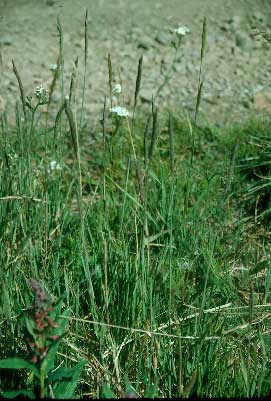Slender Wheatgrass

Common Name(s):
Slender Wheatgrass
Scientific Name:
Elymus trachycaulus (Link) Gould ex Shinners
Scientific Name Synonyms:
Agropyron trachycaulum (Link) Malte ex H.F. Lewis
Symbol:
ELTR7
Description:
Life Span: Perennial
Origin: Native
Season: Cool
Growth Characteristics: Slender wheatgrass is a bunchgrass that grows to a height of 1 to 2 ½ feet, usually without rhizomes, but tillers freely. It starts growth in mid-spring, and seeds mature by August to September. Reproduces from seeds and tillers.
Seedhead: Terminal, green to violet-tinged spike, varying from thick and dense to slender; spikelets overlapping to barely overlapping and containing 3 to 7 florets; glumes and lemmas awnless, awn-pointed, to awned; glumes nearly as long as entire spikelet.
Leaves: Lower sheaths glabrous, occasionally pubescent; blades flat to somewhat rolled, of medium width and gradually tapering to the tips. Leaves are rolled in the bud; ligules short and collar-shaped; auricles small, sometimes one or both absent.
Ecological Adaptions:
Slender wheatgrass is a native to Utah and much of the West. It is rarely abundant, but is common in a number of plant communities. It is found at elevations from 6,000 to 13,500 feet on gentle to steep mountain slopes, valley bottoms, and rolling hills, but it seldom occurs in the mountainous and hilly semi-desert zones of Utah. Slender Wheatgrass occurs on practically all of the mountain and high mountain sites, but only on a few of the upland sites. It is moderately drought resistant, as well as resistant to long wet periods, under good management. Moderately intense fires are usually survived by Slender wheatgrass, and it recovers rapidly through seed in high intensity fires.
Soils: Prefers deep, well-drained, medium to fine textured soils that are well developed. Not considered tolerant of salt and alkali but fairly tolerant to long, wet seasons.
Associated Species: Mountain brome, yarrow, Junegrass, aspen, cottonwood, and big sagebrush.
Uses and Management:
The forage value of slender wheatgrass is good, diminishing in palatability in the latter part of the growing season. In general, it is considered to be an excellent forage grass for cattle, horses, sheep, elk, and deer and valuable as cover and feed for many forms of small mammals and upland game birds as well as songbirds. Later in the growing season it becomes slightly coarse and stemmy. Grazing management should take into account the fact that this species is rather sensitive to grazing; yet it withstands grazing reasonably well and serves as an indicator of trend in the population of other valuable, associated range and watershed vegetation species.
Erosion control values are excellent, as it will quickly establish from seed. It is occasionally used for hay and in irrigated pastures.

